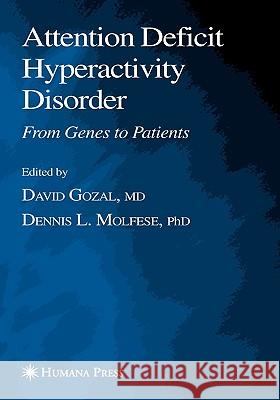Attention Deficit Hyperactivity Disorder: From Genes to Patients » książka
Attention Deficit Hyperactivity Disorder: From Genes to Patients
ISBN-13: 9781588293121 / Angielski / Twarda / 2005 / 560 str.
Attention deficit hyperactivity disorder (ADHD) is a common neurobehavioral disorder affecting 5-10% of children and adolescents and 3% of adults. Attention Deficit Hyperactivity Disorder: From Genes to Patients aims to provide a comp- hensive, state-of-the-art overview of the critical aspects of ADHD, and hopefully will serve as a quick and up-to-date reference source for professionals with an int- est in ADHD. The book is divided into three major areas that follow an historical survey. The first group of chapters deals with current theories on the pathophysiology of ADHD, and focuses on neurotransmitters and the contributions and validity of animal m- els. The second section emphasizes the evaluation and treatment of patients with ADHD, from the day-to-day approach by the clinical psychologist to the more sophisticated anatomical and functional imaging strategies that have emerged in the last decade. In addition, chapters dealing with specific impairments, such as those pertaining to reading, social interaction, and working memory, are also included for more detailed analysis of these important aspects and their respective contributions to global functioning. The third and final section provides an expanded review on the pharmacotherapy of ADHD and the appropriate methods for selection of specific drugs for individual patients based on drug kinetics and gene expression. David Gozal, MD Dennis L. Molfese, PhD vii CONTENTS Dedication . . . . . . . . . . . . . . . . . . . . . . . . . . . . . . . . . . . . . . . . . . . . . . . . . . . . . . . . . . . . . . . . . . . . . . . . . . . . . . . . . . . . . . . . . . . . . . . . . . . . . . . . . . . . . . . . . . . . . . . . . . . . . . . . . . . . . . . . . . . v Preface. . . . . . . . . . . . . . . . . . . . . . . . . . . . . . . . . . . . . . . . . . . . . . . . . . . . . . . . . . . . . . . . . . . . . . . . . . . . . . . . . . . . . . . . . . . . . . . . . . . . . . . . . . . . . . . . . . . . . . . . . . . . . . . . . . . . . . . . . . . . . . . vii Contributors. . . . . . . . . . . . . . . . . . . . . . . . . . . . . . . . . . . . . . . . . . . . . . . . . . . . . . . . . . . . . . . . . . . . . . . . . . . . . . . . . . . . . . . . . . . . . . . . . . . . . . . . . . . . . . . . . . . . . . . . . . . . . . . . . . . . . . . xi 1 Historical Aspects of Attention Deficit Hyperactivity Disorder . . . . . . . . . . . . . . . . . . . . . . . . . . . . . . . . . . . 1 Roscoe A. Dykman 2 Scanning the Genome for Attention Deficit Hyperactivity Disorder . . . . . . . . . . . . . . . . . . . . . . . . .











